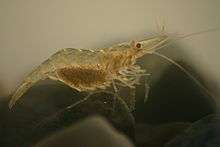Palaemonetes pugio
| Palaemonetes pugio | |
|---|---|
 | |
| Scientific classification | |
| Kingdom: | Animalia |
| Phylum: | Arthropoda |
| Subphylum: | Crustacea |
| Class: | Malacostraca |
| Order: | Decapoda |
| Infraorder: | Caridea |
| Family: | Palaemonidae |
| Genus: | Palaemonetes |
| Species: | P. pugio |
| Binomial name | |
| Palaemonetes pugio Holthuis, 1949 | |
Palaemonetes pugio (daggerblade grass shrimp) is small, transparent shrimp with yellow coloring and brownish spots. It can be found throughout the western Atlantic Ocean and Gulf of Mexico. Palaemonetes pugio has a smooth carapace and abdomen, as well as three pairs of legs. The second pair is the strongest, while the third pair lacks chelae (claws). It reaches a length of around 5 cm (2.0 in), and has a life span of around one year. Like most grass shrimp, it is a forager and feeds on a variety of items, including microalgae. They themselves are consumed by killifish and other small foraging fish.[1]
References
- ↑ Lipke B. Holthuis (1949). "Note on the species of Palaemonetes (Crustacea Decapoda) found in the United States of America" (PDF). Proceedings van de Koninklijke Nederlandsche Akademie van Wetenschappen. 52: 87–95.
Further reading
- Georgiandra Little (1968). "Induced winter breeding and larval development in the shrimp, Palaemonetes pugio Holthuis (Caridea, Palaemonidae)". Crustaceana. Supplement 2: 19–26. JSTOR 25027384.
- A. C. Broad (1957). "Larval development of Palaemonetes pugio Holthuis". The Biological Bulletin. 112 (2): 144–161. JSTOR 1539193.
- Sue A. Chaplin-Ebanks & Mary C. Curran (2005). "The effect of the parasitic isopod, Probopyrus pandalicola (Packard, 1879), on tidal activity patterns of the grass shrimp, Palaemonetes pugio Holthuis, 1949". Crustaceana. 78 (9): 1053–1061. doi:10.1163/156854005775360990. JSTOR 20107579.
External links
This article is issued from Wikipedia - version of the 9/20/2016. The text is available under the Creative Commons Attribution/Share Alike but additional terms may apply for the media files.